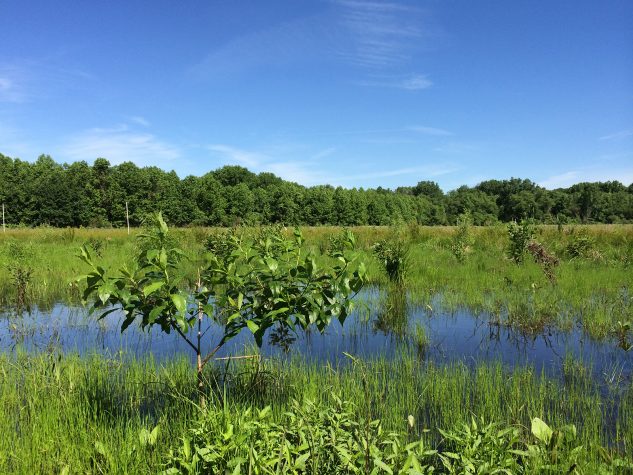by McKenzi Heger | August 14, 2019
When it comes to our environment, a little can go a long way, especially when it comes to wetland restoration. You may be asking yourself – what is wetland restoration, and why is it important for our environment? According to the EPA, wetland restoration is the manipulation of a former or degraded wetland and its characteristics, whether it be physical, chemical, or biological. The end goal is to get the wetland back to its natural functions.

Wetlands act as natural buffers, meaning they can protect and prevent damage from a selection of natural disasters. While they can contribute to flooding, wetlands also have control over the frequency and intensity of flooding as they soak up and store a large quantity of floodwater. This prevents further damage by decreasing the amount of water passing through. Along with protecting the land itself, wetlands often act as the breeding ground for various species and provide sources of food for fish, birds and other organisms. This puts even more importance on ensuring our wetlands are as healthy as possible.
When the restoration process begins, focusing on re-establishing the wetlands’ previous state and rehabilitating the functions of the degraded wetland are always top of mind. The different stages of wetland restoration start with early planning and finish with the post-implementation monitoring stage. The EPA has put together some guiding principles to keep in mind during the wetland restoration process. These include:
- Preserve and Protect Aquatic Resources: Restoring wetlands does not replace the need to protect them. Instead, restoration and protection work together so the wetlands can be improved overall.
- Restore Ecological Integrity: Restoration intends for the greatest process toward ecological integrity by using designs that favor the natural form of the ecosystem.
- Restore Natural Selection: Restoration of the wetlands back to its original form is important as it improves water quality and brings back native biota.
- Restore Natural Function: In order to maximize the benefits of the restoration project, it is important to know what natural functions should be present. After establishing this, it is critical to make the missing or impaired functions a priority in the restoration process.
- Work Within the Watershed and Broader Landscape Context: Working throughout the watershed can have negative effects on the wetlands being restored. The restoration project can be designed to accommodate watershed effects.
- Understand the Natural Potential of the Watershed: This step can show what the historical conditions of the wetland have been prior to the degradation and also give an insight on what the future conditions of the wetland might be.
- Address Ongoing Causes of Degradation: It is crucial to learn the causes of degradation, and eliminate the stress it creates whenever possible so that the restoration efforts can be successful.
- Develop Clear, Achievable and Measurable Goals: This step ensures a successful restoration process and post-implementation period.
- Focus on Feasibility: While making plans for the restoration, it is necessary to think about if the plan is possible.
- Use a Reference Site: Reference sites are areas that can be compared in structure and functions to other restoration projects. You can use reference sites as a model for other wetland restoration projects.
- Anticipate Future Changes: Though you can’t predict the future, it is important to think ahead and use previous restoration projects as a model for future changes in the current restoration project.
- Involve the Skills and Insights of a Multi-Disciplinary Team: In order to achieve the greatest success in the wetland restoration, it is important to have a team of people with knowledge working on the project.
- Design for Self-Sustainability: Restoration projects should be restored in a way to minimize the need for constant maintenance and upkeep. Some ways to do this is supplying artificial sources of water, vegetation management, or frequent repairing of damage done by high water events.
- Use Passive Restoration, When Appropriate: Passive restoration is reducing or eliminating the sources of degradation and allowing recovery time. In restoration, you can determine if passive restoration will leave enough time for the restoration site to naturally recover.
- Restore Native Species and Avoid Non-Native Species: During restoration, sometimes non-native species find their way into the habitat and take over the species that were once there. Restoring native species throughout the restoration process is very common and, sometimes, is the overall goal.
- Use Natural Fixes and Bioengineering Techniques, Where Possible: Bioengineering techniques usually are successful for erosion control and bank stabilization, flood mitigation and even water treatment which can help throughout the restoration process.
- Monitor and Adapt Where Changes Are Necessary: Before and during the restoration process, it is crucial to always monitor the project to see if it is successful. By monitoring the restoration, you can change anything necessary to be successful in the project.
GreenVest follows these guiding principles with all of their wetland restoration projects, including the Mattawoman Creek Mitigation Site, a stream and wetland restoration project located in Charles County, MD. We were commissioned by the Baltimore District of the Army Corps of Engineers and the United States Air Force at Joint Base Andrews (JBA) to develop an Umbrella Mitigation Bank to mitigate for impacts tied to planned capital improvement projects on the base. This project consisted of 80.95 acres of creation, restoration, enhancement and preservation of forested, non-tidal wetland habitat and 3,798 linear feet of stream and buffer restoration. As of June 2019, and with the help of GreenTrust Alliance, this project achieved substantial construction completion.
To learn more about wetland restoration and the completion of the Mattawoman Creek Mitigation Site, contact us today!



